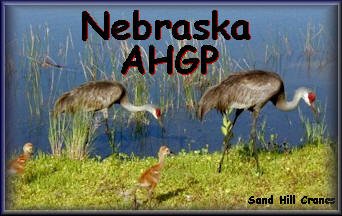Nebraska Beekeepers' Association
The Nebraska State Beekeepers' Association was organized on
February 8, 1879, at a meeting held in Omaha, the initiatory
movement having been made by T. Smith Corbett, then a citizen of
Omaha. The organization was completed by the election of the
following officers:
President, Hiram Craig, Fort Calhoun
First Vice President, J. R. Kennedy, Papillion
Second Vice President, J. H. Masters, Nebraska City
Fourth Vice President, J. W. Flynn, Fairfield
Fifth Vice President, T. L. Vandorn, Omaha
Sixth Vice President, Dr. Cochran, Tecumseh
Treasurer, J. N. Dynes, Papillion
Secretary, W. G. Pigman, Omaha
Assistant Secretary, W. C. B. Allen, Omaha |
The following comprised the membership at the first annual
meeting, held at Omaha on February 13 and 14, 1880:
W. C. Pigman
Henry Bruning
Henry Ehrenfort
T. H. Pegeler
T. L. Vandorn
John Byers
T. Smith Corbett
J J. McLain
Perry M. Peckham
B. E. B. Kennedy |
D. H. Wheeler
J. Valentine
W. H. Hart
G. Rusting
J. F. Sawyer
John G. Willis
H. Munger
W. C. B. Allen, Omaha
G. W. Brewster, Omaha
J. T. Poland, Bellevue |
Alvis Gramlich, Papillion
John Gramlich, Papillion
J. R. Kennedy, Papillion
Cyrus Latham, Papillion
J. N. Dynes, Papillion
H. Sprague, Papillion
G. M. Hawley, Lincoln
Don J. Arnold, Brownville
James W. Flynn, Fairfield |
At the annual meeting, held February 10, 1881, T. L. Vandorn of
Omaha was elected President, and held this position until
January 13, 1886, when W. F. Wright was elected President, and
Henry N. Patterson of Humboldt, Secretary. In 1887 R. R. Ryan
was elected President; Secretary, Patterson, re-elected. In 1888
M. L. Trester was elected President, and J. N. Heater of
Columbus, Secretary. Mr. Heater served three years, when L. D.
Stilson of York was elected, who has served in the capacity of
Secretary for twelve years. E. Whitcomb of Friend is now serving
his thirteenth year as President, and is one of the best known
apiarists in the country, having been at the head of Nebraska's
bee and honey exhibits at all the leading expositions for the
past fifteen years.
At the time of the organization of the Beekeepers' Association
the bee and honey industry was attracting considerable
attention, some apiaries having as much as 100 hives of bees,
and the outlook in general quite flattering. The Missouri River
Valley at this period had become famous for its numerous wild
swarms of the black honey bee. The stocking up of apiaries from
these wild swarms was quite common in those days.
From the oldest historical records of the Missouri Valley
country we find that more than 100 years ago the Indians were
apprised of the existence of bees, in what is now known as
Nebraska. In 1804-5, when the Lewis and Clark expedition passed
up the Missouri River, they found wild honey near their camp, at
a point where Dakota City now stands. It was on this occasion
and when the officers were absent visiting the Omaha tribe of
Indians located in this vicinity, that a member of the
expedition, Sergeant Floyd, while hunting along the timbered
bluffs to the southeast of the camp, found and robbed a colony
of bees, eating so much of the honey that he became sick, from
the effects of which he died the next day. The monument marking
the grave of Sergeant Floyd still stands prominent on the high
bluff overlooking the Missouri River at Dakota City. The Lewis
and Clark expedition records the earliest history of the wild
honey bee in Nebraska, given by authority of any white man.
Secretary L. D. Stilson of the Nebraska Beekeepers' Association
says in rehearsing the results of his research for the
introduction of the honey bee into Nebraska that it must be
conceded that the honey bee was a "squatter" in the American
Desert long before the white man crossed the Missouri.
He also introduces the following letter from Henry Fontenelle,
an educated Indian, dated Decatur, Nebraska, April 22, 1894:
"Your esteemed letter was
received three days ago. I have been waiting-to see some
of our oldest men of the Omahas. They say that the honey
bee has been found along the Missouri river as far back
as they can remember. I know that relatives of mine as
far back as 1840 in hunting for deer along the Missouri
river came home with skin sacks weighing 50 to 100
pounds of cooked and skimmed honey. I have heard the
Omahas tell many times of finding honey among the
hardwood timber on the Missouri 50 and 60 years ago.
Yours respectfully,
Henry Fontenelle |
The advance in beekeeping, to the present date, has been equal
to any other branch of agricultural work. From the little
beginning of a few hundred beekeepers in the state in 1879,
there are now thousands, and the resources of nectar production
are rapidly increasing. The flora of Nebraska that are of nectar
value exceed those of any other district of country. The rapid
increase of alfalfa production has supplied material for many
times doubling the present apiary capacity of the State.
The State Beekeepers' Association is one of the present-day
active and prosperous associations in Nebraska, and has a
reputation throughout the country as a practical, energetic,
up-to-date organization that is a credit to the present
management.
Nebraska AHGP

A Condensed History of Nebraska for fifty years to date,
Compiled by Geo. W. Hervey, Editor, and Published by Nebraska
Farmer Co., Omaha, Nebraska, 1903.
Nebraska Links

Hosted Free |
 |
Please stop by again!!
This page was last updated
Copyright August © 2011 -
AHGP The American History and Genealogy Project.
Enjoy the work of our webmasters, provide a link, do not copy their work.
|
![]()

![]()